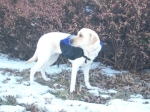
Although my Maya is in the spirit of the 4th of July, it is still not a good idea to let her go watch the fireworks.
This is a repost of our 4th of July safety post from last year:
People love fireworks. The colorful lights exploding in the night sky dazzles our eyes. The explosion excites us as we thank God that we live in the United States of America. But despite how much we love fireworks, most dogs do not like them at all.
Every year after the 4th of July the shelters get a higher volume of lost dogs. Lost dog posters can be seen in the park and the neighborhoods. Some dogs escape their yard as they try to run in fright from the terrible noise of the fireworks. Many other dogs were at the park with their owners at the fireworks when they got away. Some dogs might eventually find their way home thanks to a kind stranger or animal control, but others may never make it back.
When you go to watch fireworks this year, be sure to leave your dog safe and secure at home. If possible, keep them in a secure area inside the house. A dog in the back yard may jump or dig out in order to escape the noise. Or if he is on a chain he may break the it, slip out of his collar, or hurt himself trying to break out of it. If your dog is crate trained, keep him inside the house and inside his crate. If he is not crate trained, keep him in a quiet room. If possible, keep him in a room with no accessible windows – such as the bathroom.
You can also help your dog by turning on some familiar noise such as the radio or television. And even if your dog is indoors, make sure he is wearing his collar or tags. A desperate dog just might be able to find a way out. I have heard of dogs breaking out of windows, going through air ducts, and even managing to open an unlocked door. Tags will help to bring them home. If you find a dog this year, contact the local animal shelter and humane society. Post in the classified ads of your local newspaper. Post online too. Craig’s list is a popular place to post online. Leave fliers at local neighborhood centers and notify local residents.
If you don’t want your pet to be left out of the festivities, take your pet to the park for the 4th of July picnic. But please leave take him home before the fireworks! Enjoy the Independence Day celebration and come home to a safe and happy pet.















































